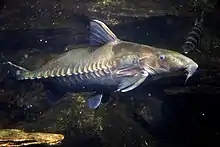Oxydoras niger
Oxydoras niger, the ripsaw catfish or cuiu cuiu, is a species of thorny catfish[1] native to the Amazon, Essequibo and São Francisco basins in Bolivia, Brazil, Colombia, Ecuador, Guyana, Peru and Venezuela. This species grows to a length of 100 centimetres (39 in) SL and weights up to 13 kilograms (29 lb). This species is a minor component of local commercial fisheries.[2] It has lateral thorns that can damage any potential predator or handler. It feeds by shifting through sand and detecting eatable parts with the taste receptors in the roof and floor of its mouth.
| Ripsaw catfish | |
|---|---|
 | |
| Scientific classification | |
| Domain: | Eukaryota |
| Kingdom: | Animalia |
| Phylum: | Chordata |
| Class: | Actinopterygii |
| Order: | Siluriformes |
| Family: | Doradidae |
| Genus: | Oxydoras |
| Species: | O. niger |
| Binomial name | |
| Oxydoras niger (Valenciennes, 1821) | |
| Synonyms | |
| |
Ecology
Oxydoras niger occurs over mud in streams and lakes. It is known from temperatures ranging from 24–29.8 °C (75–85.6 °F), pH range of 5–9, and an alkalinity range of 42–142. It is known to form schools. This species feeds on detritus, chironomid and ephemeropteran larvae, and crustaceans.[2]
In the aquarium
Oxydoras niger is a popular aquarium fish species. In the hobby, it goes by many names, including black talking catfish, razorback catfish, mother of snails catfish, ripsaw catfish and black doradid.[3] This species grows to a large size and are often bought by unsuspecting aquarists when small. They will rapidly outgrow smaller tanks, so the aquarium should be as large as possible.[3][4] O. niger is especially light shy and should be provided with sheltered areas to hide.[4] Although these fish are peaceful, very small tankmates are still at risk of being eaten.[3] This species readily accepts prepared foods.[3] O. niger has not been bred under aquarium conditions.[3]
References
- Usma, S.; Mojica, J.I.; Herrera-Collazos, E.E.; Rodríguez-Olarte, D.; Taphorn, D.C.; Villa-Navarro, F. (2022). "Oxydoras niger". IUCN Red List of Threatened Species. 2022: e.T187128A1823539. doi:10.2305/IUCN.UK.2022-1.RLTS.T187128A1823539.en. Retrieved 5 August 2022.
- Froese, Rainer; Pauly, Daniel (eds.) (2011). "Oxydoras niger" in FishBase. December 2011 version.
- "PlanetCatfish::Catfish of the Month::February 2001". PlanetCatfish.com. 2006-04-12. Retrieved 2007-06-16.
- Axelrod, Herbert R.; Emmens, C.; Burgess, W.; Pronek, N. (1996). Exotic Tropical Fishes. T.F.H. Publications. ISBN 0-87666-543-1.
![]() Media related to Oxydoras niger at Wikimedia Commons
Media related to Oxydoras niger at Wikimedia Commons
